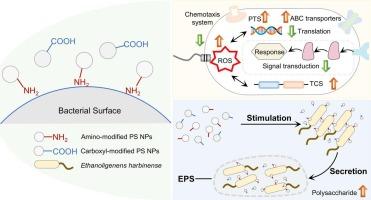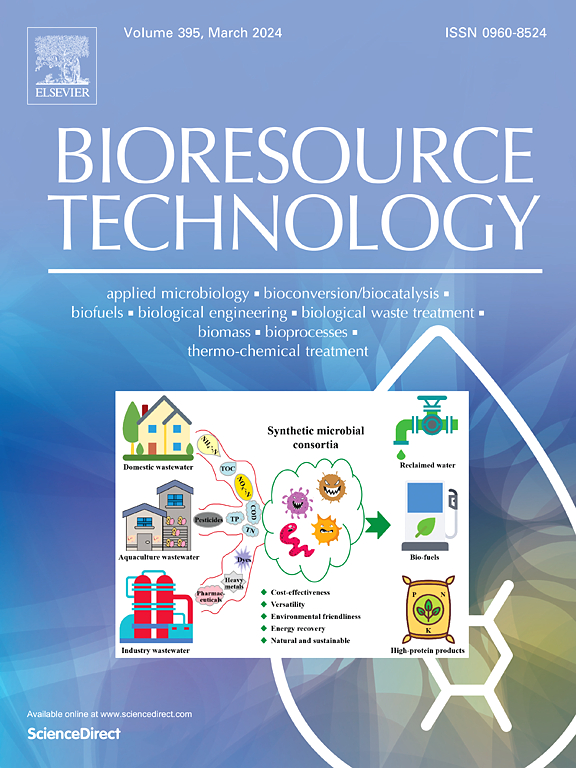Charge-specific impacts of polystyrene nanoplastics on acidogenesis and biofilm adaptation in Ethanoligenens harbinense
IF 9
1区 环境科学与生态学
Q1 AGRICULTURAL ENGINEERING
引用次数: 0
Abstract
Despite increasing awareness of the risks posed by nanoplastics (NPs) to environmental microbes, the charge-specific effects of functionalized NPs on anaerobic acidogenic bacteria remain poorly understood. This study investigated the impact of functionalized polystyrene (PS) NPs on Ethanoligenens harbinense, a model hydrogen-producing anaerobe. The growth, metabolic, and transcriptomic responses of this bacterium to non-functionalized (PS-NPs), amino-modified (PS-NH2), and carboxyl-modified (PS-COOH) variants were examined. Compared with the control group without NPs addition, PS-NH2 exerted the strongest inhibition, reducing hydrogen and ethanol production by 16 % and 20 %, respectively, while elevating reactive oxygen species (ROS) level by 148 %. It also decreased biomass and down-regulated the expression of ribosome- and translation-related genes. In parallel, biofilm adaptation resulted in an 12 % increase in polysaccharide. PS-COOH enhanced biofilm reinforcement with a 21 % increase in polysaccharides and up-regulation of bapA and membrane transporter-related genes. Overall, PS-NH2 induced broad transcriptional changes, particularly in pathways related to the phosphotransferase system (PTS), ATP-binding cassette (ABC) transporters, genetic information processing, and signaling/regulatory systems in E. harbinense. These findings provide new insights into how surface charge modifications of NPs affect anaerobic bacterial metabolism and underscore their potential environmental risks.

聚苯乙烯纳米塑料对乙烯寡聚物产酸和生物膜适应的电荷特异性影响
尽管人们越来越意识到纳米塑料(NPs)对环境微生物造成的风险,但功能化NPs对厌氧产酸细菌的电荷特异性影响仍然知之甚少。研究了功能化聚苯乙烯(PS) NPs对模型产氢厌氧菌乙二醇寡烯菌的影响。研究了该细菌对非功能化(PS-NPs)、氨基修饰(PS-NH2)和羧基修饰(PS-COOH)变异体的生长、代谢和转录组反应。与未添加NPs的对照组相比,PS-NH2的抑制作用最强,氢气和乙醇产量分别减少16%和20%,活性氧(ROS)水平提高148%。它还降低了生物量,下调了核糖体和翻译相关基因的表达。与此同时,生物膜适应导致多糖增加12%。PS-COOH增加了21%的多糖,并上调了bapA和膜转运蛋白相关基因,增强了生物膜的强化。总的来说,PS-NH2诱导了广泛的转录变化,特别是在与哈尔滨蛤的磷酸转移酶系统(PTS)、atp结合盒(ABC)转运体、遗传信息处理和信号/调控系统相关的途径中。这些发现为NPs的表面电荷修饰如何影响厌氧菌的代谢提供了新的见解,并强调了其潜在的环境风险。
本文章由计算机程序翻译,如有差异,请以英文原文为准。
求助全文
约1分钟内获得全文
求助全文
来源期刊

Bioresource Technology
工程技术-能源与燃料
CiteScore
20.80
自引率
19.30%
发文量
2013
审稿时长
12 days
期刊介绍:
Bioresource Technology publishes original articles, review articles, case studies, and short communications covering the fundamentals, applications, and management of bioresource technology. The journal seeks to advance and disseminate knowledge across various areas related to biomass, biological waste treatment, bioenergy, biotransformations, bioresource systems analysis, and associated conversion or production technologies.
Topics include:
• Biofuels: liquid and gaseous biofuels production, modeling and economics
• Bioprocesses and bioproducts: biocatalysis and fermentations
• Biomass and feedstocks utilization: bioconversion of agro-industrial residues
• Environmental protection: biological waste treatment
• Thermochemical conversion of biomass: combustion, pyrolysis, gasification, catalysis.
 求助内容:
求助内容: 应助结果提醒方式:
应助结果提醒方式:


